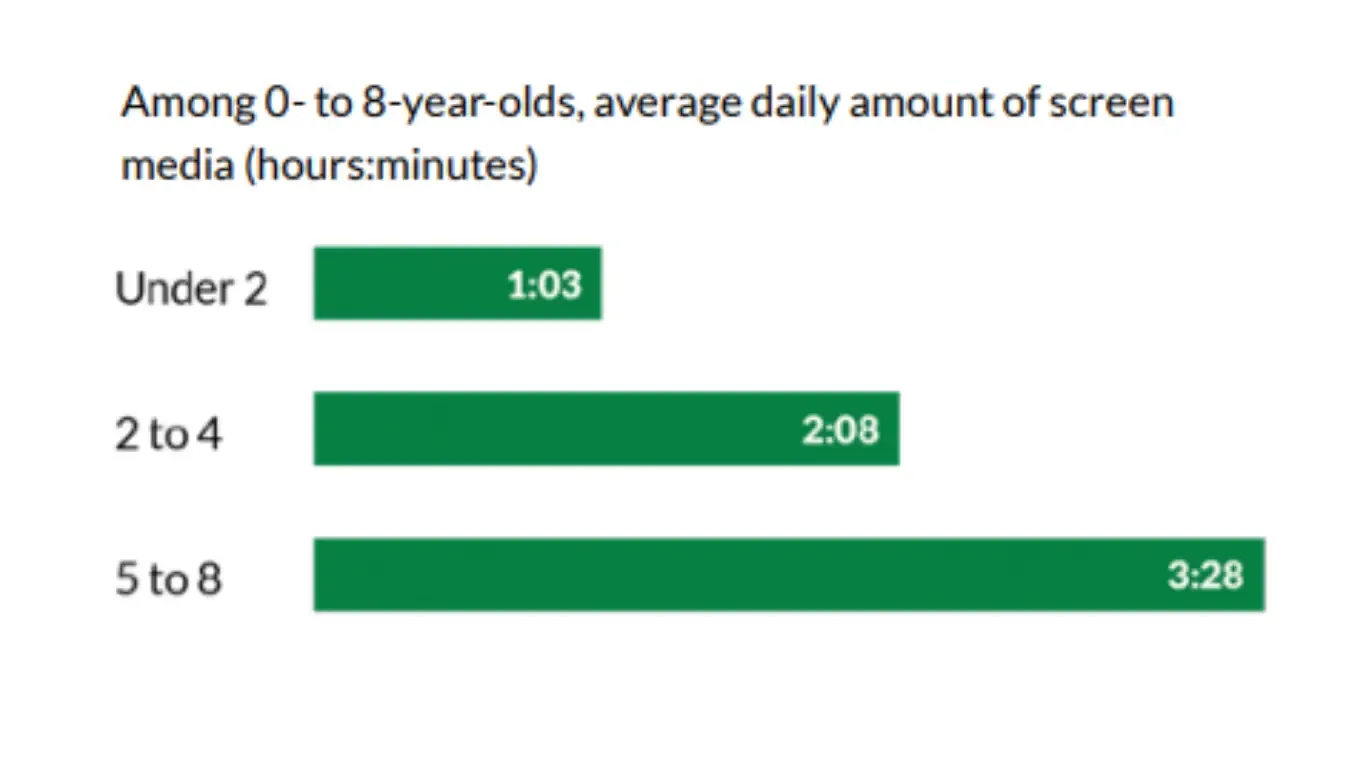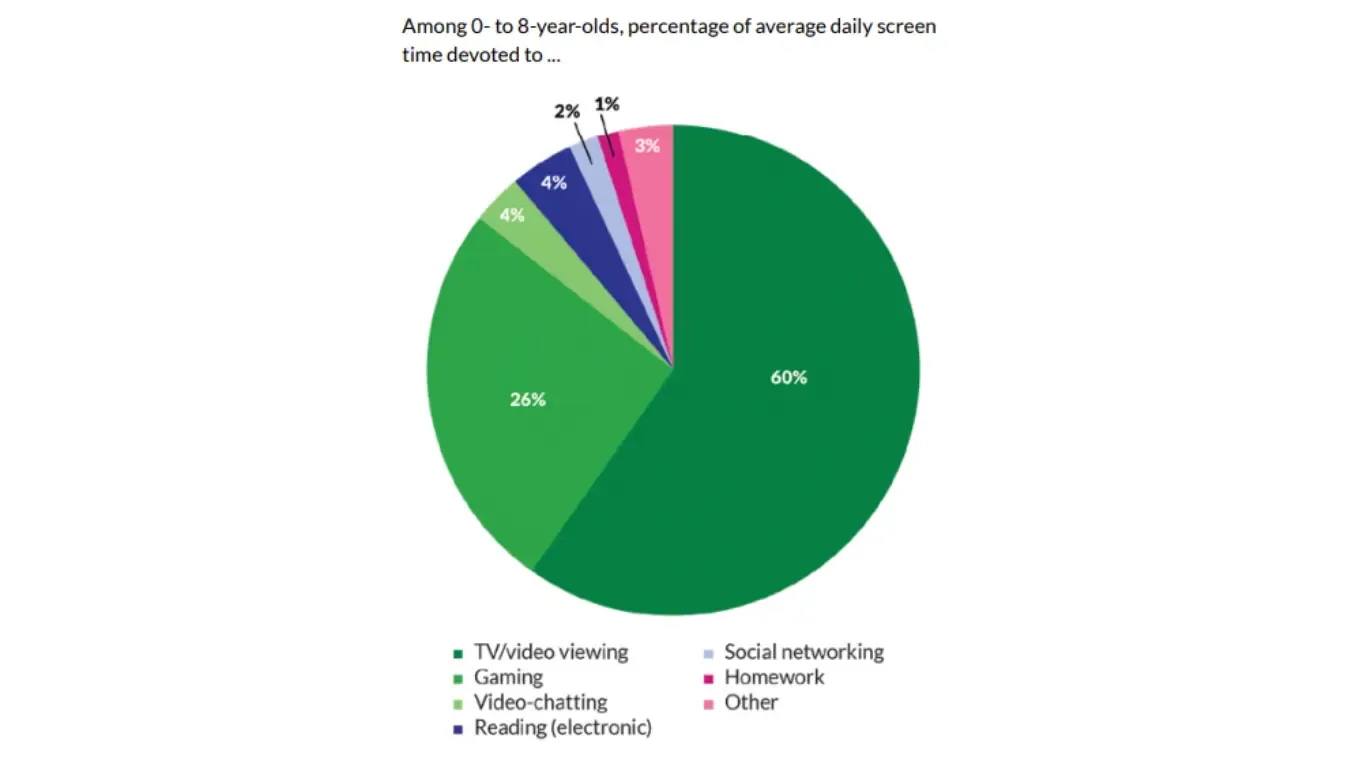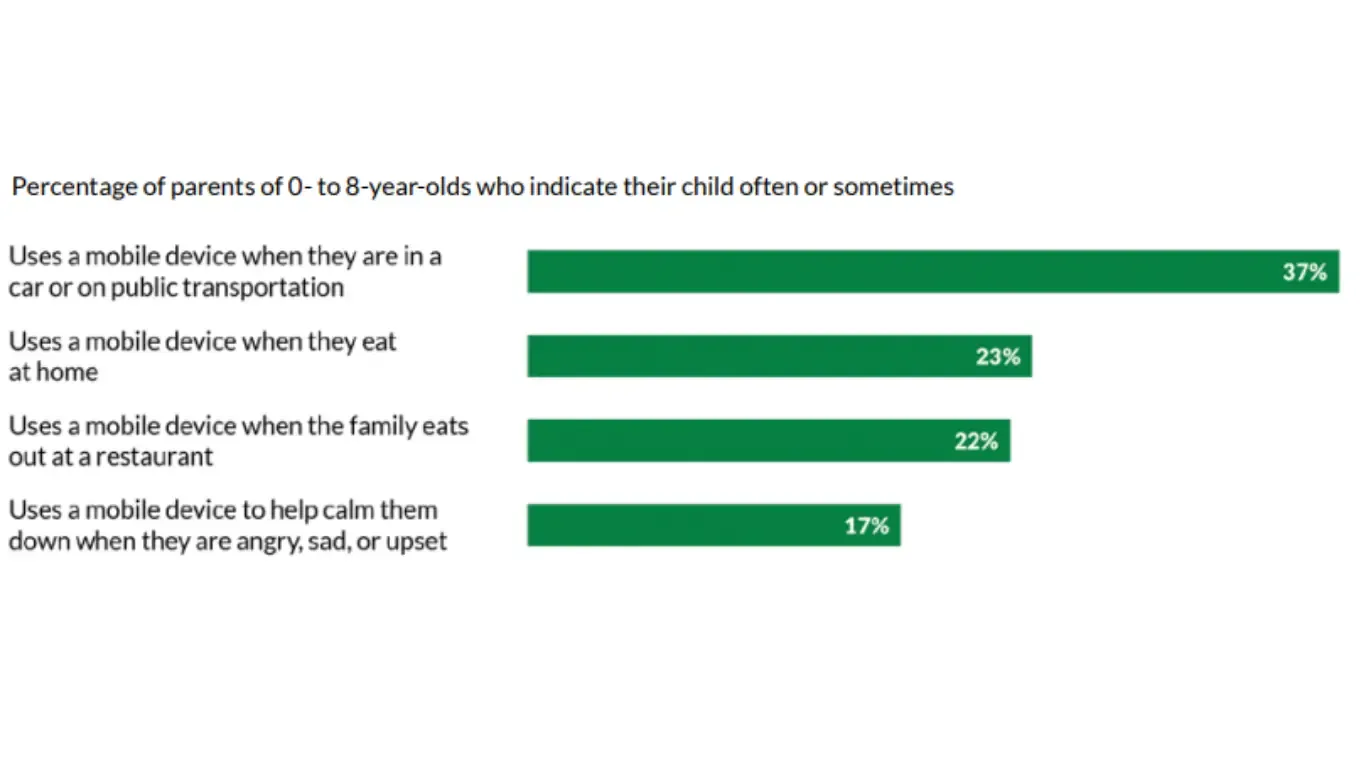How Much Screen Time Are Kids Getting in the U.S. in 2025?
TL;DR: In 2025, kids ages 0-8 spend about two and a half hours a day on screens - roughly the same as five years ago - but what they do has shifted: less live TV, more short-form videos and gaming. Nearly half of preschoolers now own a tablet, and by age eight, one in four have a phone. Parents often feel torn about screen time. Research shows both risks and benefits: too much screen time is linked to attention and mood problems, while certain activities, like gaming, may also support memory and thinking skills. This makes screen time less about being “good” or “bad” and more about how it’s used. What matters most is turning those minutes into something meaningful, rather than letting them slip away on endless scrolling.
If you’ve ever handed your toddler a tablet just to enjoy five quiet minutes, you’re not alone. In 2025, screens are practically stitched into the fabric of family life. Whether it's a tablet soothing a toddler during a grocery run or a preschooler absorbed in a YouTube video, screen time is often a parent’s co-pilot. But how much is too much? And what are young kids really doing with their screens?
This look at kids’ device use, habits, and parental attitudes is based on the 2025 Common Sense Census: Media Use by Kids Age 0–8, the latest national survey tracking how technology shapes young childhood.
Are Kids Ages 0–8 Actually Spending More Time on Screens in 2025?
Not exactly - but the way they’re using screens has changed dramatically. Since 2020, overall daily screen time has stayed about the same, yet kids are shifting away from traditional TV toward short-form videos, gaming, and interactive content.
- Average daily screen media use for kids ages 0–8: 2 hours 27 minutes/day (about the same as 2020’s 2:24).
- By age group:
- Under 2 years old: 1 hour 3 minutes/day
- Ages 2–4: 2 hours 8 minutes/day
- Ages 5–8: 3 hours 28 minutes/day

- Gender gap: Boys spend 30+ minutes more daily than girls (2:38 vs. 2:07), especially with video games and TV/video watching.
- Income gap: Kids from homes earning <$50K use screens ~2 hours more/day than kids in $100K+ homes (3:48 vs. 1:52).
- Shifts in use since 2020:
- Less live TV/cable.
- Short-form video (TikTok, YouTube Shorts, Instagram Reels) jumped from 1 min/day to 14 min/day.
- Gaming rose from 23 min/day to 38 min/day.
- Video chatting climbed from 1% to 4% daily use.
A systematic review of school-aged children (ages 6–14) across 53 studies found that, on average, kids in this age range spend 2.77 hours per day in front of screens - and nearly half (46%) exceed 2 hours daily. The study reported that “the average rates of school-aged children who had screen time within the range of ≥2 hours per day were 41.3% and 59.4% respectively before and after January 2020” - a clear jump in excessive screen use since the pandemic.
Overall, the type of content kids consume has changed dramatically - with short, bite-sized videos leading the charge.
Beyond just tracking hours, recent research suggests that exceeding 1 hour of daily screen time may have real developmental consequences. In a large Canadian study of 3-year-olds, children who spent 2 or more hours per day on screens were 30% to 90% more likely to show behavioral issues, nearly twice as likely to struggle with vocabulary, and significantly more likely to miss key developmental milestones compared to peers who stayed under an hour.
How Many Kids Ages 0–8 Have Their Own Devices in 2025?
You might think preschoolers are too young for their own gadgets - but the numbers tell a different story.
- 51% of kids in this age group have their own mobile device.
- Nearly 1 in 2 (47%) own a tablet, often as their first piece of personal tech.
- 19% own a smartphone, and 9% have a cellphone of some kind:
- 79% are fully functional smartphones.
- 19% are kid-friendly “limited” phones like Pinwheel or Bark.
- 3% are old-school feature phones with no apps or internet.
For many kids, their first screen is one they can carry around - and by elementary school, personal tech is already a norm.
But device ownership isn’t just about access - it also affects how young children’s brains develop. Research shows that toddlers who use touchscreens heavily are more likely to orient quickly to sudden distractions but struggle to disengage attention, suggesting weaker long-term focus.
More recently, studies have linked frequent preschool touchscreen use with differences in executive function, including challenges with self-control and flexible thinking.
Together, this suggests that while it’s increasingly normal for kids to get their own devices by preschool, early personal ownership may reinforce habits of distraction rather than focus.
How Common Are Devices in U.S. Households?
As we talk about kids’ screen use, it’s worth asking: just how easy is it for them to get their hands on a device?
- 96% own a smartphone - making it practically a household essential.
- 75% have a tablet, from iPads to Galaxy Tabs.
- In total, 97% of households have at least one mobile device.
- Wearables are also on the rise: 48% own a smartwatch, and 19% have a fitness tracker like a Fitbit or Oura Ring.
With device access this high, avoiding screens altogether is less about availability - and more about active choices.
At What Age Do Kids Start Owning Devices?
The hand-me-down tablet era starts shockingly early.
Tablet ownership:
- 58% of ages 5-8 have one.
- 45% of ages 2-4 already have their own.
- Even 40% of 2-year-olds have their own tablet.
Cellphone ownership:
- 13% of ages 5-8 have one.
- 5% of ages 2-4 have a phone.
- By age 8, nearly 1 in 4 (23%) kids have their own phone.
The “first phone” milestone is creeping earlier - with nearly a quarter of kids ringing in their 8th birthday with their own device.
What Are Kids Ages 0–8 Really Doing on Their Screens in 2025?

TV & videos still dominate
Nearly two-thirds of all screen time for kids ages 0-8 is spent watching shows, movies, or online videos, cementing this as the number one media activity for young children. Within that, streaming has overtaken traditional TV: children are watching less live TV or cable than in previous years, shifting instead to on-demand platforms and YouTube.
Among children who watch online videos:
- 65% watch “learning videos” (covering topics like numbers, shapes, or basic science). Within this group:
- 59% watch animal-related content.
- 57% watch general educational programs like Sesame Street.
- 55% watch nursery rhymes or children’s music.
Younger kids (ages 2-4) are especially likely to watch nursery rhymes and educational shows, while older kids (ages 5-8) increasingly watch DIY or “how to” videos (56% of them, vs. 30% of ages 2-4)
Short-form videos are the fastest climber
Platforms like TikTok, YouTube Shorts, and Instagram Reels have become a major fixture in kids’ screen habits. Average daily time spent on short-form video jumped from just 1 minute in 2020 to 14 minutes in 2024 - a 14× increase in four years. This growth is part of a broader shift toward bite-sized, high-engagement content. While most children under 8 are not officially on these apps due to age restrictions, they often access short-form content through YouTube or watch clips shared by parents, older siblings, or embedded in other apps.
But this shift toward quick, high-stimulation clips may come with trade-offs. Studies of short-form video “addiction” show that heavy users find it harder to stay focused - both while watching and afterward. Compared to non-addicted viewers, they spend less time holding their attention on one thing, get distracted more easily, and perform more slowly and less accurately on follow-up attention tasks. In other words, the constant novelty of short videos may be training young brains to crave quick hits of stimulation, making it tougher to concentrate when focus really matters.
Gaming: The Second-Biggest Slice of Kids’ Screen Time
Gaming has firmly secured its spot as the second most popular screen activity for children ages 0-8, making up 26% of their total screen use. About 2 in 5 (42%) children in this age group play video games.
In 2020, young kids spent just 23 minutes a day gaming; by 2024, that number had surged to 38 minutes a day - a 65% increase in just four years.
While gaming time has risen across all devices, the biggest leap came from playing on smartphones and tablets, which saw an 8-minute increase in average daily playtime since 2020.
The gender gap is striking: Boys spend significantly more time gaming than girls, helping explain why boys overall clock 30+ extra minutes of daily screen time. This gap is consistent across age groups, but becomes most pronounced in the 5–8-year-old range, when interest in video games really spikes.
Gaming preferences vary by age:
- Ages 2-4 tend to play simple educational games or character-based apps tied to popular kids’ shows.
- Ages 5-8 gravitate toward more complex and competitive games, including multiplayer and adventure-style games, often on consoles or tablets.
A large U.S. study of 9–10 year olds found that children who played three or more hours of video games daily performed better on memory and impulse-control tests. But in the same group, researchers also saw significantly more attention problems, depressive symptoms, and ADHD-like behaviors. Because the results are correlational, we don’t know whether gaming caused these effects, or whether kids with those traits are simply more drawn to gaming.
Additional studies with U.S. children highlight the trade-offs: while some benefits are seen, kids who gamed more were also a bit more likely to experience sadness or low mood over time.
What Do Parents Really Think About Their Kids’ Screen Time?
Parents in 2025 are caught between two opposing instincts - the urge to limit screen time and the recognition that devices are now an essential part of childhood. The Common Sense Census reveals just how conflicted, yet pragmatic, parents have become.
Mixed feelings are the norm
When it comes to screen time, most parents are walking a tightrope between concern and appreciation. They see both the risks and the rewards - and their feelings often depend on the type of content, the amount of time, and their child’s habits.
Top concerns:
- 80% worry about too much screen time, and 79% about its effect on attention spans.
- Around three-quarters are concerned about sexual or violent content, social media’s impact on mental health, and cyberbullying.
- Many also worry about data collection (73%), advertising (72%), and body image issues (69%).
Biggest positives:
- 75% value the learning opportunities media can offer.
- 72% appreciate exposure to positive messages and new interests.
- 71% see it as a way for kids to connect with friends and family.
Screens as Modern Parenting Tools
For many parents, screens are more than entertainment - they’re a quick fix for everyday challenges. Two-thirds (66%) say they sometimes hand over a device just to keep their child occupied.
Devices show up in daily routines:
- 23% of kids ages 0–8 use one while eating at home, 22% at restaurants, and 37% in the car or on public transit.
- 1 in 5 kids under 8 use a device most nights to fall asleep (rising to 26% among ages 5–8).
- 25% of parents use screens to calm an upset child; 17% say their child uses a mobile device for emotional regulation.

Despite their prevalence, 77% of parents have never discussed screen use with a pediatrician. Most also avoid tech-based limits - 75% don’t use time restrictions, and 51% don’t control content. Parents of older children (ages 5-8) are more likely to set screen limits (30% vs. 4% of parents with children under 2).
How Often Do Parents Join In?
When it comes to media, parents are more likely to watch alongside their child than to actively play or use apps together.
- 74% co-watch their child’s TV shows at least sometimes.
- 62% co-watch YouTube videos
- 42% co-use apps or games on smartphones or tablets.
- 27% play console video games with their child.
- TikTok sees the least parent participation - only 17% watch TikTok videos together.
Parental judgment on screen time isn’t black and white. While 35% of parents feel their child spends too much time with media, a majority (59%) believe the amount is just right.
In 2025, screens aren’t just part of childhood - they are childhood for many kids. The overall hours haven’t skyrocketed since 2020, but what’s on those screens has changed fast: more TikTok-style clips, more gaming on tablets, and far less live TV. Parents are still walking that fine line - worrying about attention spans, online safety, and too much screen time, while also recognizing how much tech can help kids learn, laugh, and stay connected.
How Should Parents Approach Screen Use with Young Kids?
(Based on recommendations from the American Academy of Pediatrics)
- Delay introduction: Avoid screen media (other than video chat) for children younger than 18 months. If parents do introduce screens at 18–24 months, choose only high-quality apps/programming and use them together with your child. Solo use at this age should be avoided.
- Stick to the 1-hour rule for preschoolers: For ages 2–5, keep daily screen use to 1 hour or less of high-quality content, ideally co-viewed. Focus on programs that are slow-paced, non-violent, and encourage interaction.
- Make it shared and social: Screens work best when they spark conversations. Watch with your child, ask questions, and help them connect what they see on a screen to the world around them.
- Keep family times screen-free: Meals, bedrooms, and parent–child playtimes should be device-free. This helps protect sleep and preserves quality time.
- Avoid using screens as the only calming tool: While media can help in special circumstances (like long flights), relying on it too often may make it harder for kids to develop their own self-regulation skills.
- Choose quality content: Rely on trusted resources like Common Sense Media to find age-appropriate, research-backed content.
- Set healthy routines: Turn off TVs and devices when not in use, and avoid screens for at least an hour before bedtime. Remove devices from bedrooms to protect sleep
The truth is, screens aren’t disappearing anytime soon. The real challenge is turning that time into something meaningful - swapping endless scrolling for shows that spark curiosity, games that build skills, or even just moments spent watching and talking together. Because in the end, it’s not about how many minutes kids get on a screen, but how much those minutes give back.
FAQs
How much screen time is too much for kids under 8?
Most pediatric guidelines recommend no more than 1 hour per day of high-quality programming for preschoolers, with consistent limits for older kids. Yet studies show that many children average 2–3 hours daily.
Does screen time actually harm kids’ development?
Research suggests that excessive screentime can increase risks for behavior problems, weaker vocabulary, mood issues, and shorter attention spans. However, content and context matter: when screens are used for co-viewing, learning activities, or creative play, they can become tools that spark curiosity and support healthy development.
Is gaming good or bad for children?
It’s not simply good or bad - it’s both. Studies show that children who game heavily may score better on skills like memory and impulse control, but they can also show higher rates of attention problems and mood symptoms. Balance is key: setting limits, encouraging breaks, and choosing age-appropriate content helps kids get the best out of games without slipping into overuse. And when those games are educational titles like Monster Math, the benefits can be even stronger - a recent meta-analysis found that well-designed learning games boost not just cognitive growth, but also social, emotional, and motivational development.
How can parents manage screen time without constant battles?
Experts recommend:
- Setting clear daily limits and routines.
- Prioritizing educational or creative content.
- Co-watching or co-playing when possible.
- Keeping screens out of bedrooms, especially at night.
- Swapping some screen time for offline play, reading, and outdoor activities.
References:
- Common Sense Media (2025). Common Sense Census: Media Use by Kids Age 0–8.
- Screen time among school-aged children of aged 6–14: a systematic review
- Screen time and developmental and behavioral outcomes for preschool children
- Longitudinal touchscreen use across early development is associated with faster exogenous and reduced endogenous attention control
- Do pre-schoolers with high touchscreen use show executive function differences?
- The effect of short-form video addiction on users' attention
- Video gaming may be associated with better cognitive performance in children
- Screen time and mental health: a prospective analysis of the Adolescent Brain Cognitive Development (ABCD) Study
- American Academy of Pediatrics : Media and Young Minds
- Game-based learning in early childhood education: a systematic review and meta-analysis
